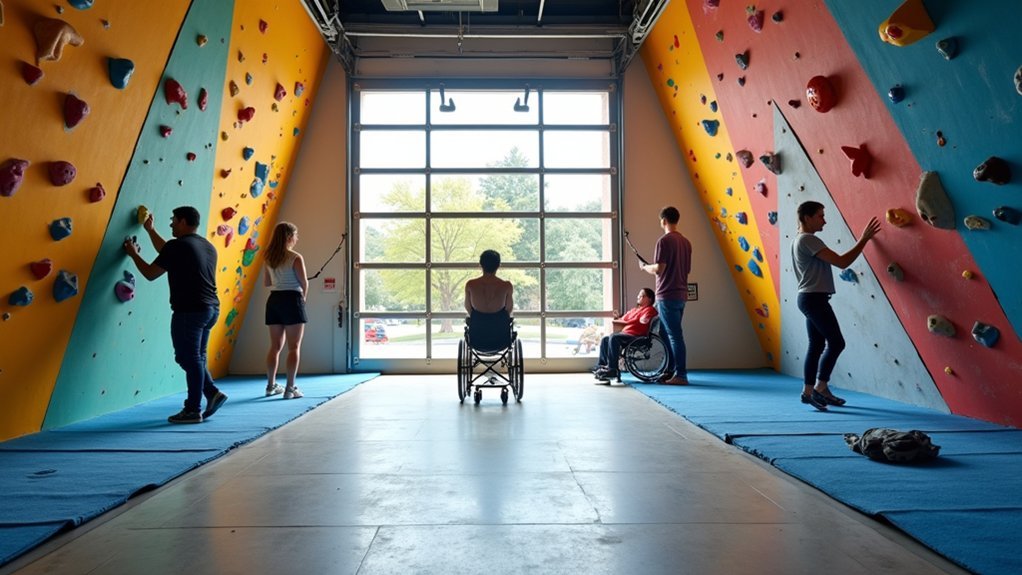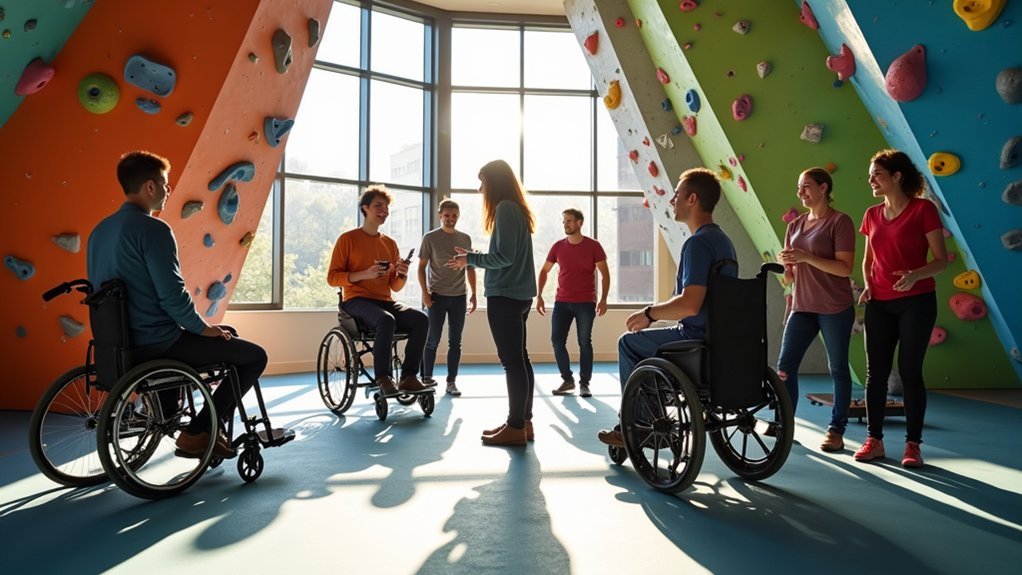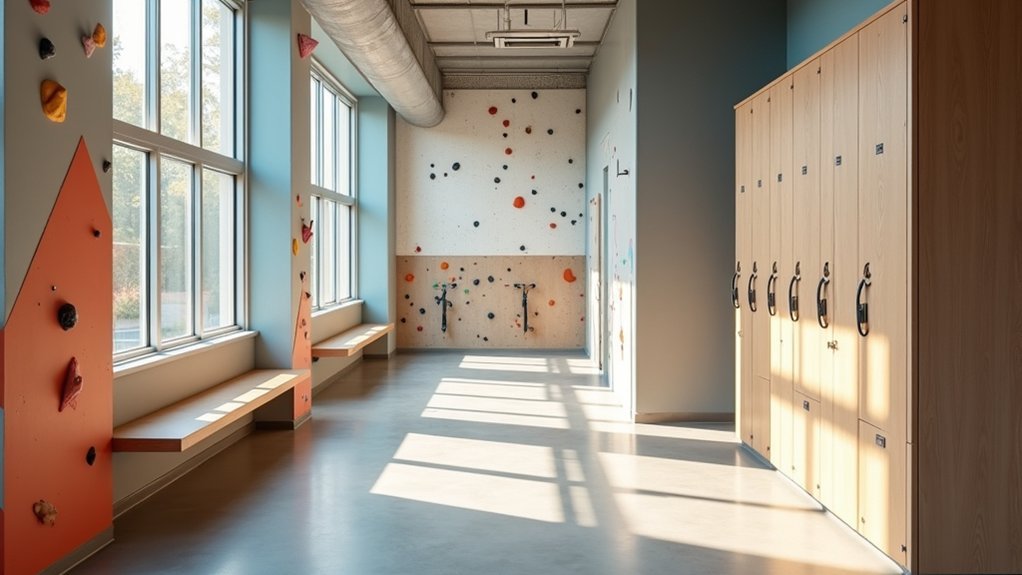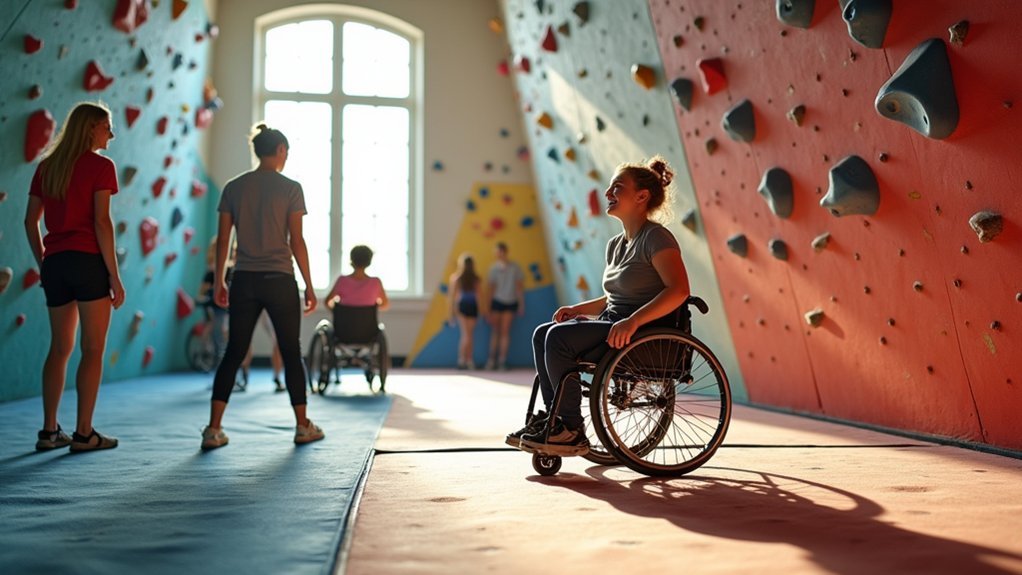When searching for wheelchair-accessible climbing gyms, look beyond minimum ADA requirements. The best facilities offer ramped entrances, automatic doors, spacious pathways, and accessible check-in counters. Truly inclusive gyms provide adaptive equipment like specialized harnesses and train staff to assist without assuming limitations. Focus on gyms with roll-under sinks, properly positioned grab bars, and accessible changing areas. These thoughtful access points transform you from an accommodated visitor into a valued community member ready for vertical adventures.
Physical Entry Points: Beyond Basic Compliance

While ADA compliance serves as a baseline for accessibility, climbing gyms should aim higher to create truly inclusive environments.
Your facility’s journey to accessibility begins before climbers enter the building. Evaluate the entire path from parking lots to all gym areas, ensuring clear, unobstructed routes throughout.
Accessibility isn’t just about your climbing walls—it begins in your parking lot and extends through every corridor and space.
Your check-in desk should accommodate guests at seated height, allowing wheelchair users to comfortably register and communicate with staff.
Don’t overlook the importance of supportive features like strategically placed handrails and appropriate flooring that enhance mobility without creating new obstacles.
Adaptive Climbing Equipment and Technology
Four essential categories of adaptive climbing equipment are revolutionizing access for climbers with disabilities. Specialized harnesses, including sit harnesses and upper body support systems, enable climbers with limited mobility to engage safely with the wall.
You’ll find these customizable options increasingly available at forward-thinking gyms.
Innovative technologies like adaptive holds and adjustable walls create personalized climbing experiences tailored to your specific abilities.
Meanwhile, climbing wheelchairs and specialized prosthetics are emerging to enhance your independence and performance on the wall.
The collaboration between organizations and manufacturers guarantees this equipment meets rigorous safety standards while remaining functional.
When you use these assistive devices, you’re not just accessing the physical sport—you’re joining a supportive community that celebrates diverse climbing approaches and fosters genuine belonging.
Staff Training for Inclusive Assistance

Staff training programs should focus on mastering adaptive climbing techniques tailored to various disabilities while building confidence in using specialized equipment.
You’ll need to incorporate disability etiquette fundamentals that emphasize respectful communication, appropriate assistance offers, and understanding various mobility challenges.
Regular practice sessions where your staff role-play different scenarios help solidify these skills and create a more welcoming environment for climbers of all abilities.
Staff Training for Inclusive Assistance
Effective training programs serve as the cornerstone for creating truly accessible climbing environments for adaptive climbers.
You’ll need to guarantee your staff undergoes thorough training focused on understanding the specific needs and challenges faced by climbers with disabilities.
Incorporate role-playing scenarios to enhance problem-solving skills and build empathy among your team members. These exercises prepare staff for real-world adaptive climbing situations they’ll encounter.
Train your team to communicate clearly with adaptive climbers, prioritizing their safety and comfort throughout their experience.
Educate staff on various adaptive equipment and proper assistance techniques to foster an inclusive atmosphere.
Don’t forget to schedule regular workshops and refresher courses to keep your team updated on best practices and new developments in adaptive climbing methods and equipment.
Adaptive Climbing Techniques
The foundation of successful adaptive climbing programs lies in equipping your staff with specialized belaying techniques that accommodate diverse needs. Train your team to master adaptive climbing techniques that promote independence and confidence among climbers with varying abilities.
| Adaptation Type | Technique |
|---|---|
| Hand Amputee | Modified rope handling with wrist wraps |
| Arm Amputee | Single-arm belay systems with anchor assists |
| Seated Climber | Low-angle belay positioning and pulley systems |
| Visual Impairment | Verbal cues and tactile route mapping |
| Mobility Limited | Counterweight systems and adapted harnesses |
Incorporate problem-solving exercises in your training to help staff adapt on the fly for individual needs. Regular workshops keep your team’s skills fresh while fostering an inclusive climbing community. Remember that thoughtful routesetting is equally important—consider varying reach limitations and visual markers to create truly accessible climbing experiences.
Disability Etiquette Fundamentals
Beyond mastering technical adaptive climbing techniques, your team needs a solid foundation in disability etiquette to create a truly inclusive gym environment.
Implement thorough training that covers various disability types and appropriate assistance methods for adaptive climbers.
Role-playing exercises greatly improve staff confidence when addressing real-world situations. Confirm your team understands the importance of inclusive language and proper interaction approaches.
Schedule regular workshops to keep staff updated on best practices, as accommodation techniques evolve constantly.
Encourage your team to engage directly with adaptive climbers and solicit their feedback about their experiences.
This proactive approach to disability etiquette training doesn’t just benefit climbers with disabilities—it elevates the experience for everyone at your facility by fostering a culture of respect and inclusion.
Bathroom and Changing Room Accessibility

You’ll need adequately sized stalls with grab bars to guarantee all climbers can use restroom facilities comfortably and safely.
Changing benches must be installed at varying heights to accommodate both wheelchair users and those with different mobility needs.
Sink placement should prioritize accessible reach zones, with lever-style faucets and lowered mirrors helping everyone prepare for their climbing session with dignity.
Stall Size Matters
While many climbing gym owners focus primarily on climbing walls and equipment accessibility, bathroom and changing room facilities deserve equal attention for creating truly inclusive spaces.
You’ll need stalls at least 60 inches wide to meet ADA requirements for wheelchair accessibility. Remember that door swings matter too—outward-swinging or automated doors prevent awkward maneuvering in tight spaces.
Install grab bars strategically to support climbers with mobility challenges as they transfer from wheelchairs.
In changing areas, guarantee there’s sufficient space for wheelchair users to approach benches unobstructed.
Don’t forget that accessibility isn’t a one-time fix—regularly seek feedback from climbers with disabilities about your bathroom facilities.
These simple adjustments to stall size and layout can transform your climbing gym from merely accessible to genuinely welcoming for all athletes.
Changing Bench Heights
After establishing proper stall dimensions, bench heights become the next critical design element in accessible bathroom and changing facilities.
You’ll want to guarantee benches sit between 17 to 19 inches from the floor—this ideal height accommodates wheelchair users who need to transfer comfortably.
Position these benches strategically near entrances and exits to minimize navigation challenges for those with mobility devices. Your climbing gym’s accessibility greatly improves when users don’t need to traverse obstacles to reach changing areas.
Consider installing handrails alongside benches to provide additional support for climbers who require stability assistance during changes.
Don’t underestimate the value of gathering feedback from adaptive athletes about bench heights and placement—their input can guide meaningful improvements to your facility’s design, making your gym truly inclusive for all climbers.
Sink Reach Zones
Three critical measurements define effective sink reach zones in accessible bathrooms and changing rooms.
When you’re designing for accessibility, guarantee sinks are positioned at appropriate heights for wheelchair users to reach comfortably while providing adequate clearance underneath.
- Position sinks at a maximum height of 34 inches from the floor to accommodate seated users
- Maintain clear floor space of at least 30 by 48 inches in front of each sink
- Install mirrors with the bottom edge no higher than 40 inches from the floor
- Provide lever-style faucets that don’t require gripping or twisting
- Place soap dispensers and hand dryers within reach zones (no higher than 48 inches)
Regular assessments of these specifications guarantee your changing rooms remain compliant with accessibility standards while creating a welcoming environment for all climbers, regardless of mobility constraints.
Creative Routesetting for Diverse Abilities
Because climbing represents freedom of movement, routesetters must design with inclusivity in mind to guarantee everyone can experience this joy. When setting routes for diverse abilities, you’ll need to take into account various climbing styles and adaptations.
| Route Type | Benefit | Who It Serves | Implementation |
|---|---|---|---|
| Overhang with large holds | Provides space for seated climbers | Wheelchair users | Place holds closer together |
| Corner routes | Creates unique body positioning options | Sit-climbers | Include ledges for resting |
| High-contrast paths | Enhances visibility of sequence | Visually impaired | Use contrasting hold colors |
| Redirected topropes | Improves safety and access | All adaptive climbers | Set directional draws |
Take into account incorporating these elements into both bouldering and roped climbing sections. Well-designed corner routes with ample ledges offer critical rest positions while climbing, making walls more navigable for everyone.
Success Stories From Wheelchair Climbers
Wheelchair athletes have shattered preconceptions about what’s possible in climbing, demonstrating that adaptive techniques can conquer seemingly insurmountable challenges.
You’ll find inspiration in how these climbers navigate specialized climbing holds and develop their own methods to ascend routes.
- Catalyst Sports participants regularly complete routes previously labeled “impossible,” using innovative adaptive techniques.
- Wheelchair climbers now compete in bouldering events alongside able-bodied peers.
- Many have mastered independent belaying methods for top-rope climbing.
- Some climbers have pioneered new approaches to gripping challenging climbing holds.
- Success stories continue to influence gym design, inspiring more accessible routes.
These achievements aren’t just personal victories—they’re transforming the climbing community’s understanding of accessibility and pushing gyms to create truly inclusive environments where adaptive equipment and modified techniques are welcomed and celebrated.
Gym Layout and Navigation Considerations
You’ll notice a significant difference in climbing gyms that prioritize clear navigational pathways, allowing all climbers to move independently throughout the facility.
Well-designed gyms feature unobstructed routes from parking areas to check-in desks, with pathways wide enough for mobility devices and free of hazardous obstacles.
Mobility-friendly check-in areas with adjustable-height counters further enhance accessibility, ensuring your first interaction with the facility is comfortable and dignified.
Clear Navigational Pathways
How easily can all visitors navigate your climbing gym? The hallmark of a truly accessible facility lies in its thoughtfully designed pathways that welcome everyone, regardless of mobility needs.
When evaluating your space, consider these essential elements:
- Wide, unobstructed pathways between climbing zones, check-in areas, and restrooms
- Clear signage at appropriate heights with high-contrast colors and simple directions
- Floor markings or textural changes to indicate shifts between different gym areas
- Strategic placement of handrails along corridors and near stairs for added support
- Open sightlines throughout the facility to help visitors easily locate key areas
Remember that accessibility isn’t just about compliance—it’s about creating independence for all your climbers.
Regular feedback from adaptive athletes will help you continually refine your navigation systems.
Mobility-Friendly Check-In Areas
The experience of entering a climbing gym sets the tone for what follows. Your first interaction typically happens at the check-in desk, which must accommodate all climbers regardless of mobility status.
Check-in counters should be positioned at a height accessible from a seated position, ensuring wheelchair users can comfortably register and communicate with staff.
A truly mobility-friendly check-in area features adequate turning space, clear pathways, and non-slip flooring. You’ll appreciate counters with knee clearance underneath and staff trained to assist without being intrusive.
The best gyms regularly collect feedback about their accessibility features, making improvements based on real user experiences.
When evaluating climbing gyms, consider how the entrance and check-in process feels—it often indicates the facility’s overall commitment to creating an inclusive climbing environment for everyone.
Community Programs and Adaptive Climbing Groups
While climbing gyms offer exciting physical challenges for many, their true potential shines brightest when they’re accessible to everyone in the community.
You’ll find that partnerships with existing adaptive sports organizations can dramatically enhance your climbing experience if you have mobility challenges.
Many forward-thinking gyms now offer:
- Dedicated bouldering leagues and competitions for climbers with disabilities
- Exclusive adaptive climbing events that create welcoming environments
- Staff trained specifically to accommodate diverse mobility needs
- Regular collaboration with community adaptive climbing groups
- Awareness programs highlighting opportunities for all mobility levels
These community programs and adaptive climbing groups don’t just provide access—they create belonging.
When gyms prioritize inclusivity through specialized programming, everyone benefits from the enriched climbing community that forms when all abilities are welcomed and celebrated.
Membership Options and Financial Accessibility
Beyond physical accessibility, financial barriers often determine who can enjoy climbing’s benefits. Silver Street Climbing Gym addresses this challenge through diverse membership options that fit various budgets and needs.
You’ll find individual, family, and student rates that make climbing more accessible to a wider audience.
Looking for extra savings? The gym regularly offers promotional deals on memberships and classes. If you’re planning a group outing, take advantage of group rates for a more cost-effective experience.
Parents will appreciate that financial assistance programs and scholarships may be available for youth programs, ensuring children from all backgrounds can participate.
Your membership isn’t just about gym access—it’s a gateway to exclusive events, specialized classes, and the Member Directory, considerably enhancing your climbing journey’s value.
The Future of Inclusive Climbing Spaces
As climbing continues to evolve, forward-thinking gyms are forging meaningful partnerships with adaptive sports organizations to revolutionize accessibility.
You’ll see inclusive climbing spaces transforming beyond basic ramps to all-encompassing environments where adaptive climbers can navigate independently.
- Route designs featuring larger holds and ledgy paths accommodating various mobility levels
- Thorough accessibility evaluations covering navigation routes, check-in areas, restrooms, and climbing zones
- Innovative adaptive belaying techniques empowering climbers with disabilities
- Strategic partnerships with disability sport groups enhancing specialized programming
- Architectural designs prioritizing inclusivity from conception rather than as afterthoughts
The growing community of adaptive climbers is driving this evolution, pushing gyms to reimagine what accessibility truly means.
Adaptive climbers aren’t just participating—they’re reshaping the climbing industry’s fundamental understanding of inclusivity.
You’ll find tomorrow’s climbing spaces aren’t just accessible—they’re genuinely inclusive environments where everyone can experience the joy of climbing.
Frequently Asked Questions
Is 35 Too Old to Start Rock Climbing?
No, you’re not too old to start at 35! Many climbers begin in their 30s or later. Your body’s still capable, and climbing communities are increasingly welcoming to newcomers of all ages.
How Many Times a Week Should You Go to the Climbing Gym?
You should visit the climbing gym 2-3 times weekly as a beginner, 3-4 times as an intermediate, and 4-6 times as an advanced climber. Always include rest days and listen to your body’s recovery needs.
Is Climbing a 5.9 Good?
Climbing a 5.9 is definitely good, especially if you’re new to climbing! It’s a respectable achievement that shows you’re developing fundamental skills. You’re mastering basic techniques that’ll prepare you for more challenging routes ahead.
How Do You Meet People at the Climbing Gym?
Join the Adult Climbing Club, take Learn To Climb Classes, attend events on the Silver Street Calendar, volunteer for routesetting, or participate in group training sessions. You’ll naturally meet people who share your climbing passion.
In Summary
You’ve now seen that accessible climbing isn’t just about ramps and elevators—it’s about creating a community where everyone can experience the thrill of vertical challenges. By supporting gyms that prioritize universal access and speaking up for improvements, you’re helping transform the climbing world. Remember, true accessibility means everyone feels welcome, regardless of how they move through the world. Keep climbing, keep advocating.





Leave a Reply